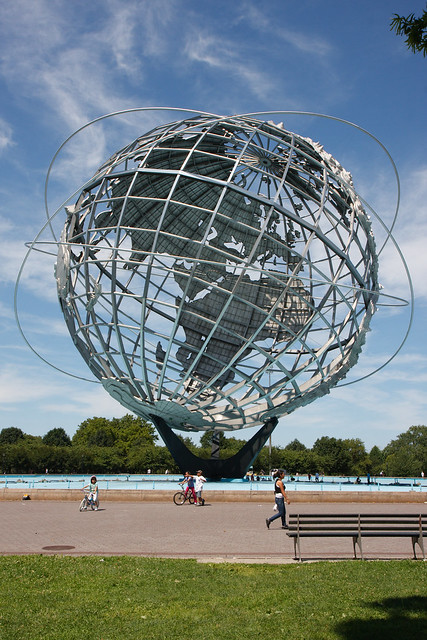The structure I'm talking about is the Unisphere. It even got a
little boost in the 1997 "Men in Black" movie, when the story had it
destroyed by a crashing flying saucer.
It would take a lot to destroy this spherical stainless steel
representation of the Earth. It holds a special place in my heart
because I was present for the 1964-65 World's Fair. People streamed into Flushing Meadows NY for that spectacular affair. The Unisphere was
constructed as the symbol. Today it is one of the few remaining
artifacts.
The World's Fair had an ironic theme: "Peace through
understanding." Our country was in fact on the cusp of terrible
divisiveness as we were to plunge into the Viet Nam War and experience
other social tumult. The apex of the war was probably 1967.
The World's Fair had a peaceful and optimistic outlook that should
have been borne out in our country's direction. It was not. But the
purpose was noble.
The Cold War seemed to send certain forces spinning out of control.
It was a strange and sort of paranoid time. The World's Fair sought to
brush all of that aside, imploring us to think of peace and harmony.
Because of its purity in this regard, the Fair is a touchstone in
the memory of boomers in the New York City area. And, for all who
visited like yours truly who was there because of the University of
Minnesota-Morris men's chorus. Our singing lads with their signature
maroon blazers visited the World's Fair in Seattle (1962) and New York
(1964). They helped put UMM on the map. UMM was in its fledgling days.
The men's chorus performed in a spirited way.
The Unisphere is a prevailing symbol in my memories. It rises up in
its steel splendor in Corona Park, Borough of Queens. It was built not
just to represent the Fair, but to celebrate the beginning of the Space
Age.
Three rings circle it, representing the orbits of the first U.S.
astronaut, the first Russian cosmonaut and the first communications
satellite to orbit the Earth.
We learn that "locals don't pay much attention" to it anymore.
Perhaps residents of Paris don't pay much attention to the Eiffel Tower
either. But I would argue the Unisphere deserves the same iconic status.
Occasionally we do see it in the background of a TV commercial or in
other fleeting ways. But it's too fleeting and incidental.
The New York Mets were still a new team in 1964. Their home of Shea
Stadium was so close to the fairgrounds, it appeared on fair maps. The
'64 season was their first at Shea as they had moved from the old Polo
Grounds in Manhattan. They were in their third year. They hadn't yet
shook the image of mediocrity so well established at their inception.
The Mets played at Shea Stadium from 1964 to 2008. They went from
being horrible in 1962 to winning the World Series in 1969. Their
heroics in '69 were helped along by West Central Minnesota native and
WCSA graduate Jerry Koosman.
My family strongly considered attending a New York Mets game during
our stay for the World's Fair, as I remember. But we did not. There
were so many things to do and see. It seemed endless.
You might say the New York World's Fair had a special atmosphere of
class because it had no true midway. I'm talking a "honky tonk" type of
midway. No, this World's Fair was a true exposition. And while this was
classy and laudable, the lack of that midway probably hurt attendance.
Organizers were hoping for 70 million. Instead they got 51 million.
Hey, the UMM men's chorus was worth the price of admission! Oh, and
the admission price was $2 in 1964 and $2.50 in '65. For kids the price
was $1. One dollar! What a value.
In addition to that theme of peace, so ironic, the Fair was planned
as a showcase for mid-20th Century U.S. culture and technology. The Fair ran
for two six-month seasons: April through October in 1964 and April
through October in 1965.
It was also a grand consumer show. Many people got their first
interaction with computer equipment. Back then we thought of computers
as bulky, esoteric and kept in back offices away from the public.
I fondly remember the Sinclair "Dinoland" with its life-size
replicas of nine different dinosaurs. Ford introduced its Mustang
vehicle at the Fair. The Mustang ended up making an even bigger
impression than the Unisphere.
If only the "Peace through understanding" theme had really spread
across America and its leaders. It reflected such fundamental common
sense. Instead we fell into the abyss of war, civil rights struggles and
a generally turbulent time.
Young people fought to find the joy of life as they always do. They
gravitated to the Monkees musical group. And of course we had the
Beatles. Our family came upon a genial street vendor by our hotel in
Manhattan who wore a Beatles wig! Remember the "mop tops?" The New York
World's Fair coincided with "Beatlemania," that phase that began with "I
Wanna Hold Your Hand."
The New York World's Fair has receded in our collective memory. But
the Unisphere remains. It's like a rock, indeed, weighing as it does
700,000 pounds. The people who craft our popular culture should pay more
attention to it. It should take no back seat to the Eiffel Tower or Taj
Mahal.
- Brian Williams - morris mn minnesota - bwilly73@yahoo.com























No comments:
Post a Comment